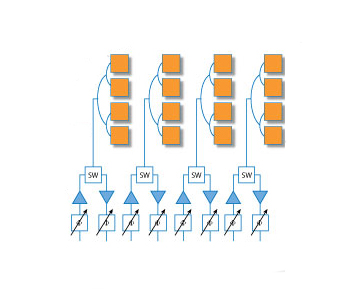Active mmWave antennas are expected to be rolled out in unprecedented volumes over the next few years, fueled by the rapidly emerging 5G telecommunications infrastructure and high throughput satellite (SATCOM) markets. mmWave spectrum is attractive for these new high-capacity systems due to the availability of large bands of contiguous spectrum.
Using active antennas allows highly-directive antenna beams to be formed by physically-small apertures, which helps offset the higher path loss associated with these high frequencies. The highly-directive beams allow spectral reuse through spatial diversity. These planar antennas offer fast, steerable beams; low size and weight; and can be cost-effectively produced in high volume. Active antennas also provide excellent reliability, since there are no moving parts, and the failure of a few elements in the array has little effect on the overall antenna performance.

Figure 1 Trade-off criteria for active antennas.
This article will look at some of the key considerations for active antennas and address what is needed to make deployment successful. Two predominant architectural implementations will be compared, and analog, digital and hybrid beamforming will be discussed relative to the two implementations.
Active Antenna Considerations
As with any technology, there are considerations to effectively deploy active antennas, particularly at mmWave (see Figure 1). The primary considerations are mass producibility at the lowest possible recurring cost, thermal management, technical performance—such as effective isotropic radiated power (EIRP) for the transmitter and the ratio of receive antenna gain to system noise temperature (G/T) for the receiver—and elimination of array calibration. Secondary considerations include beam scan volume, beam steering update rate and regulatory compliance (i.e., 3GPP, FCC, ETSI).
Mass producibility and elimination of array calibration affect cost, as do EIRP and G/T. If the arrays are not architected efficiently, then they must be oversized to compensate, adding hardware cost. Beam update rate and scan volume are important for waveform timing, tracking moving targets and providing maximum spatial coverage. Thermal management is critical for reliable operation of the array. Finally, compliance to regulatory requirements, such as FCC and ETSI spectral masks and off-axis emissions, are required for authorized deployment. Another key consideration is the manufacturing process. Planar construction enables low-cost, surface-mount assembly methods and mass producibility. Simple scaling the size of the antenna printed circuit board (PCB) and number of antenna elements allows a single manufacturing flow to support arrays of various sizes, for multiple applications.
Two main planar architectures predominate for emerging mmWave active antennas. The following sections describe the two, drawing conclusions about their relative strengths and weaknesses.

